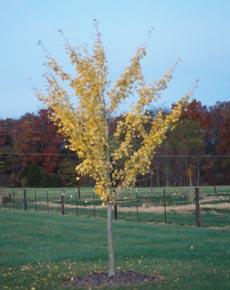Ginkgo biloba 'Autumn Gold'
2003 Theodore Klein Plant Award Winners
 Ginkgo biloba is well-known as a prehistoric tree, the only member of the Ginkgoaceae family, for that matter the only member of the Ginkgoales Order. A very distinctive plant with a unique leaf and very nice habit with age. As a young plant Ginkgo are considered gangly and irregular in shape, but with age the habit becomes an attention getter, "spectacular" says Mike Dirr. 'Autumn Gold' could be used to describe all Ginkgos when in fall color, 'Autumn Gold's' yellow-gold fall color is "better that the rest". For those that do not want the "Ginkgo Stinko" (the smell of the ripened fruit) in their yards 'Autumn Gold' is a fruit-less male selection. Selecting a male cultivar for the landscape is considered important as it takes 20-25 years for a Ginkgo to flower and fruit, quite a long time to wait to find out if you got the "right one". 'Autumn Gold' Ginkgo was selected in 1951 in San Jose, CA by M. Van Rensselaer and introduced by the Saratoga Horticultural Foundation, California (see Van Rensselaer, M. 1956. J. Cal. Hort. Soc. 17: 100-101). Ginkgo biloba grows at a moderate rate, normally somewhat taller that wide, and is hardy in zones 4-8. The name Ginkgo (Ginkyo) is said to mean "silver apricot' in Chinese. I have eaten Ginkgo fruit in China and found it to be a bit starchy. The leaves are made into tea considered to have medicinal benefits.
Ginkgo biloba is well-known as a prehistoric tree, the only member of the Ginkgoaceae family, for that matter the only member of the Ginkgoales Order. A very distinctive plant with a unique leaf and very nice habit with age. As a young plant Ginkgo are considered gangly and irregular in shape, but with age the habit becomes an attention getter, "spectacular" says Mike Dirr. 'Autumn Gold' could be used to describe all Ginkgos when in fall color, 'Autumn Gold's' yellow-gold fall color is "better that the rest". For those that do not want the "Ginkgo Stinko" (the smell of the ripened fruit) in their yards 'Autumn Gold' is a fruit-less male selection. Selecting a male cultivar for the landscape is considered important as it takes 20-25 years for a Ginkgo to flower and fruit, quite a long time to wait to find out if you got the "right one". 'Autumn Gold' Ginkgo was selected in 1951 in San Jose, CA by M. Van Rensselaer and introduced by the Saratoga Horticultural Foundation, California (see Van Rensselaer, M. 1956. J. Cal. Hort. Soc. 17: 100-101). Ginkgo biloba grows at a moderate rate, normally somewhat taller that wide, and is hardy in zones 4-8. The name Ginkgo (Ginkyo) is said to mean "silver apricot' in Chinese. I have eaten Ginkgo fruit in China and found it to be a bit starchy. The leaves are made into tea considered to have medicinal benefits.
